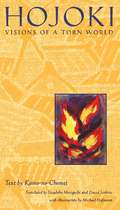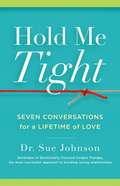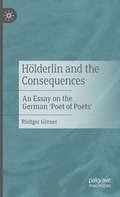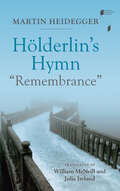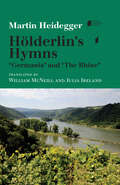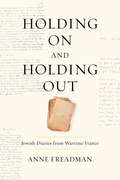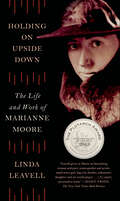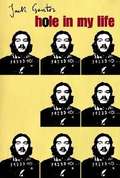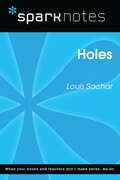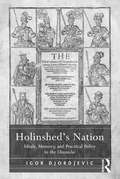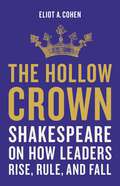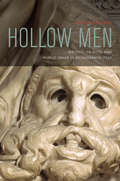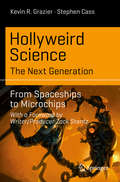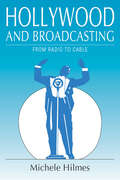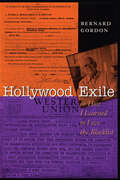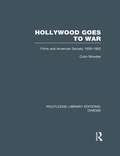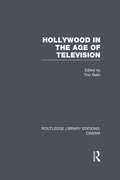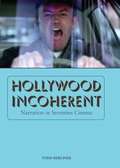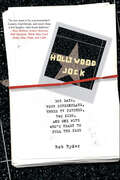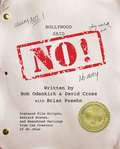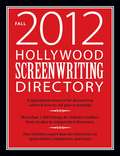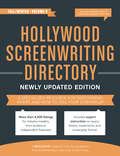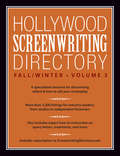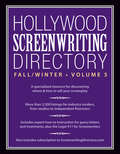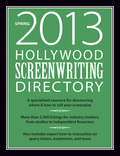- Table View
- List View
Hold Me Tight: Seven Conversations for a Lifetime of Love
by Sue JohnsonHeralded by the New York Times and Time magazine as the couple therapy with the highest rate of success, Emotionally Focused Therapy works because it views the love relationship as an attachment bond. This idea, once controversial, is now supported by science, and has become widely popular among therapists around the world. In HOLD ME TIGHT, Dr. Sue Johnson presents Emotionally Focused Therapy to the general public for the first time. Johnson teaches that the way to save and enrich a relationship is to reestablish safe emotional connection and preserve the attachment bond. With this in mind, she focuses on key moments in a relationship--from Recognizing the Demon Dialogue to Revisiting a Rocky Moment--and uses them as touch points for seven healing conversations. Through case studies from her practice, illuminating advice, and practical exercises, couples will learn how to nurture their relationships and ensure a lifetime of love.
Hölderlin and the Consequences: An Essay on the German 'Poet of Poets'
by Rüdiger Görner"A sign we are, uninterpreted. Painless we are and have almost / lost the language in a foreign country." Thus begins the second version of Friedrich Hölderlin's hymn dedicated to goddess of memory, Mnemosyne. "Hölderlin and the Consequences" wants to remember this 'poet of poets' and consider what his unmatched poems have stimulated, even triggered, in others. This scholarly essay examines the legacy of a poet who was, by and large, ostracized in his time, a master of language, who was declared a stranger by his contemporaries until he became a stranger to himself. Hölderlin's multiple experience of foreignness and alienation was later counteracted by often ideologically motivated attempts to appropriate him. Rüdiger Görner presents this complex context as a special case in recent literary history.This book is a translation of an original German 1st edition, "Hölderlin und die Folgen" by Rüdiger Görner, published by J.B. Metzler, imprint of Springer-Verlag GmbH Germany, part of Springer Nature in 2016. The translation was done with the help of artificial intelligence (machine translation by the service DeepL.com). The author (with the support of Josh Torabi) has subsequently revised the text further in an endeavour to refine the work stylistically.
Hölderlin's Hymn "Remembrance" (Studies in Continental Thought)
by Martin Heidegger“This faithful and readable translation . . . serves as a critical orientation to interpreting Heidegger’s later thought” inspired by Hölderlin’s poetry (Christopher D. Merwin, Emory University).Over the course of 1941–42, Martin Heidegger delivered a lecture course on Friedrich Hölderlin’s hymn, “Remembrance.” Immediately following his confrontation with Nietzsche, it lays out a detailed plan for the interpretation of Hölderlin’s poetry in which remembrance is a central concern. With its emphasis on the “free use of the national” and the “holy of the fatherland,” the course marks an important progression in Heidegger’s political thought.In addition to its startlingly innovative analyses of greeting, the festive, and the dream, the text provides Heidegger’s fullest elaboration of the structure of commemorative thinking in relationship to time and the possibility of an “other beginning.” This English translation by William McNeill and Julia Ireland completes the series of Heidegger’s major lecture courses on Hölderlin.
Hölderlin's Hymns: "Germania" and "The Rhine" (Studies in Continental Thought)
by Martin Heidegger“Translated with skill and precision, these lectures . . . present the most penetrating analysis of two of Hölderlin’s most significant hymns” (Choice).Martin Heidegger’s 1934–1935 lectures on Friedrich Hölderlin’s hymns “Germania” and “The Rhine” are considered the most significant among Heidegger’s lectures on Hölderlin. Coming at a crucial time in his career, the text illustrates Heidegger’s turn toward language, art, and poetry while reflecting his despair at his failure to revolutionize the German university and his hope for a more profound revolution through the German language, guided by Hölderlin’s poetry.These lectures are important for understanding Heidegger’s changing relation to politics, his turn toward Nietzsche, his thinking about the German language, and his breakthrough to a new kind of poetic thinking.“[This translation], including a clear and concise introduction and useful glossaries, attains both accuracy and clarity, rarely faltering in its choice of words.” —Notre Dame Philosophical Reviews
Holding On and Holding Out: Jewish Diaries from Wartime France
by Anne FreadmanExamining the diary as a particular form of expression, Holding On and Holding Out provides unique insight into the experiences of Jews in France during the Second World War. Unlike memoirs and autobiographies that reconstruct particular life stories or events, diaries record daily events without the benefit of retrospect, describing events as they unfold. Holding On and Holding Out assesses how individuals used diaries to record their daily life under persecution, each waiting for some end with a mix of hope and despair. Some used the diary to bear witness not only to the terror of their own lives, but also to the lives and suffering of others. Others used their writing as a memorial to people who were killed. All used their writing to assert: "I live, I will have lived." Holding On and Holding Out follows the diaries of two specific individuals, Raymond-Raoul Lambert and Benjamin Schatzman, from their first entry to the last one they wrote before they disappeared into the Nazi extermination camps. The author concludes the book by considering how reflections on their experience are informed by the times in which they lived, before the advent of persecution.
Holding On Upside Down: The Life and Work of Marianne Moore
by Linda LeavellThis “perceptive and elegant biography” of modernist poet Marianne Moore “captures well the strange and entrancing drama” of her life (The Wall Street Journal).Winner of the Plutarch Award for the Best Biography of 2013In the popular imagination, Marianne Moore is dignified, white-haired, and demure in her tricorne hat. She lives with her mother until the latter’s death. She maintains meaningful friendships with fellow poets but never marries or falls in love.Linda Leavell’s Holding On Upside Down—the first biography of Moore written with the support of her family’s estate—delves beneath the surface of this calcified image to reveal a passionate, canny woman caught between genuine devotion to her mother and an irrepressible desire for freedom. Her many poems about survival are revealed to be not just quirky nature studies but acts of survival themselves.As a young poet, Moore joined the Greenwich Village artists and writers who wanted to overthrow all her mother’s pieties. She also won their admiration for the radical originality and technical proficiency of her verse. After her mother’s death thirty years later, the aging recluse transformed herself into a charismatic performer and beloved celebrity. She won virtually every literary prize available to her and was widely hailed as America’s greatest living poet.Elegantly written, meticulously researched, critically acute, and psychologically nuanced, Holding On Upside Down provides at last the biography that this major poet and complex personality deserves.
Hole in My Life
by Jack GantosIn the summer of 1971, Jack Gantos was an aspiring writer looking for adventure, cash for college tuition, and a way out of a dead-end job. For ten thousand dollars, he recklessly agreed to help sail a sixty-foot yacht loaded with a ton of hashish from the Virgin Islands to New York City, where he and his partners sold the drug until federal agents caught up with them. For his part in the conspiracy, Gantos was sentenced to serve up to six years in prison. <P><P> Winner of the Sibert Honor
Holes (SparkNotes Literature Guide Series)
by SparkNotesHoles (SparkNotes Literature Guide) by Louis Sachar Making the reading experience fun! Created by Harvard students for students everywhere, SparkNotes is a new breed of study guide: smarter, better, faster.Geared to what today's students need to know, SparkNotes provides:chapter-by-chapter analysis explanations of key themes, motifs, and symbols a review quiz and essay topics Lively and accessible, these guides are perfect for late-night studying and writing papers.
Holinshed's Nation: Ideals, Memory, and Practical Policy in the Chronicles
by Igor DjordjevicRaphael Holinshed's account of English history from 1377-1485 in the Chronicles of England, Scotland, and Ireland is most well-known as the source of Shakespeare's English history plays. Although the Chronicles are widely read and studied, published scholarly opinion, with a few exceptions, has been limited to the discipline of history. This book explores the historiographic materials of the Chronicles through a literary lens, focusing on how Renaissance men and women read historical texts, framed by these questions: How did Holinshed understand and view history? What were his motives in composing the Chronicles? What did sixteenth- and seventeenth-century English readers learn from the work? Igor Djordjevic explores both the lexical and semantic dimensions as well as lessons in both foreign and domestic policy in the 1577 and 1587 texts and in writers who used or appropriated the Chronicles, including Shakespeare, Daniel, Heywood, and Milton. This study revaluates our understanding of Renaissance chronicle history and the impact of Holinshed on Tudor, Jacobean, and Caroline political discourse; the Chronicles emerge not as a series of rambling, digressive episodes characteristic to a dying medieval genre, but as the preserver of national memory, the teacher of prudent policy, and a builder of the commonwealth ideal.
The Hollow Crown: Shakespeare on How Leaders Rise, Rule, and Fall
by Eliot A. CohenWhat Shakespeare&’s plays can teach us about modern-day politics William Shakespeare understood power: what it is, how it works, how it is gained, and how it is lost. In The Hollow Crown, Eliot A. Cohen reveals how the battling princes of Henry IV and scheming senators of Julius Caesar can teach us to better understand power and politics today. The White House, after all, is a court—with intrigue and conflict rivaling those on the Globe&’s stage—as is an army, a business, or a university. And each court is full of driven characters, in all their ambition, cruelty, and humanity. Henry V&’s inspiring speeches reframe John F. Kennedy&’s appeal, Richard III&’s wantonness illuminates Vladimir Putin&’s brutality, and The Tempest&’s grace offers a window into the presidency of George Washington. An original and incisive perspective, The Hollow Crown shows how Shakespeare&’s works transform our understanding of the leaders who, for good or ill, make and rule our world.
Hollow Men: Writing, Objects, and Public Image in Renaissance Italy
by Susan GaylardThis book relates developments in the visual arts and printing to humanist theories of literary and bodily imitation, bringing together fifteenth- and sixteenth-century frescoes, statues, coins, letters, dialogues, epic poems, personal emblems, and printed collections of portraits. Its interdisciplinary analyses show that Renaissance theories of emulating classical heroes generated a deep skepticism about self-presentation, ultimately contributing to a new awareness of representation as representation.Hollow Men shows that the Renaissance questioning of “interiority” derived from a visual ideal, the monument that was the basis of teachings about imitation. In fact, the decline of exemplary pedagogy and the emergence of modern masculine subjectivity were well underway in the mid–fifteenth century, and these changes were hastened by the rapid development of the printed image.
Hollyweird Science: The Next Generation
by Kevin R. Grazier Stephen CassInformative, entertaining and upbeat, this book continues Grazier and Cass's exploration of how technology, science, and scientists are portrayed in Hollywood productions. Both big and small-screen productions are featured and their science content illuminated--first by the authors and subsequently by a range of experts from science and the film world. Starring roles in this volume are played by, among other things, computers (human and mechanical), artificial intelligences, robots, and spacecraft. Interviews with writers, producers, and directors of acclaimed science-themed films stand side by side with the perspectives of scientists, science fiction authors, and science advisors. The result is a stimulating and informative reading experience for the layperson and professional scientist or engineer alike. The book begins with a foreword by Zack Stentz, who co-wrote X-Men: First Class and Thor, and is currently a writer/producer on CW's The Flash.
Hollywood and Broadcasting: From Radio to Cable (Illinois Studies Communication)
by Michele Hilmes"Michele Hilmes has produced an excellent introduction to a most important subject. This is an invaluable work for both scholars and students that places film, radio, and television within the context of the national culture experience." --- American Historical Review "Hilmes is one of the few historians of broadcasting to move beyond a political economy of the media. . . . Her work should serve as a model for future histories of broadcasting." --- Journal of Communication "All media historians will find this work a critical addition to their bookshelves." --- American Journalism "A major addition to media history literature." --- Journalism History
Hollywood Exile: Or How I Learned to Love the Blacklist (Texas Film and Media Studies Series)
by Bernard GordonThe Hollywood blacklist, which began in the late 1940s and ran well into the 1960s, ended or curtailed the careers of hundreds of people accused of having ties to the Communist Party. Bernard Gordon was one of them. In this highly readable memoir, he tells a engrossing insider's story of what it was like to be blacklisted and how he and others continued to work un-credited behind the scenes, writing and producing many box office hits of the era. Gordon describes how the blacklist cut short his screenwriting career in Hollywood and forced him to work in Europe. Ironically, though, his is a success story that includes the filmsEl Cid, 55 Days at Peking, The Thin Red Line, Krakatoa East of Java, Day of the Triffids, Earth vs. the Flying Saucers, Horror Express, and many others. He recounts the making of many movies for which he was the writer and/or producer, with wonderful anecdotes about stars such as Charlton Heston, David Niven, Sophia Loren, Ava Gardner, and James Mason; directors Nicholas Ray, Frank Capra, and Anthony Mann; and the producer-studio head team of Philip Yordan and Samuel Bronston. In 1997, the Writers Guild of America began publicly re-crediting screenplays to their blacklisted authors. Bernard Gordon's name has appeared more often than any other. Now retired after a thirty-year career, he lives in Los Angeles.
Hollywood Goes to War: Films and American Society, 1939-1952 (Routledge Library Editions: Cinema)
by Colin ShindlerA historian’s view of the relationship between American history and the American film industry, this book is a witty and perceptive account of Hollywood and its films in the years from the outbreak of the Second World War in Europe to the end of the war in Korea, It describes how film makers and their industry were shaped by and responded to the strong political and social stimuli of wartime America. The author examines the recurring question of whether the movies were a reflection of the society in which they were produced, or whether by virtue of their undeniable propaganda power the films shaped that society. Combining evidence from literary, visual and oral sources, he covers a wide range of movies, emphasising in particular Casablanca, Mrs Miniver, The Best Years of Our Lives and Since You Went Away. In addition to placing the films in a social and political context, the author shows that Hollywood is a perfect example of the bone-headed way in which people behave when they are dealing with large amounts of money and power. Enjoyably nostalgic, this book will appeal to film enthusiasts as well as those interested in war and its effect on society.
Hollywood in the Age of Television (Routledge Library Editions: Cinema)
by Tino BalioThis collection of papers examines the evolving relationship between the motion picture industry and television from the 1940s onwards. The institutional and technological histories of the film and TV industries are looked at, concluding that Hollywood and television had a symbiotic relationship from the start. Aspects covered include the movement of audiences, the rise of the independent producer, the introduction of colour and the emergence of network structure, cable TV and video recorders. Originally published in 1990.
Hollywood Incoherent: Narration in Seventies Cinema
by Todd BerlinerIn the 1970s, Hollywood experienced a creative surge, opening a new era in American cinema with films that challenged traditional modes of storytelling. Inspired by European and Asian art cinema as well as Hollywood’s own history of narrative ingenuity, directors such as Martin Scorsese, Robert Altman, William Friedkin, Stanley Kubrick, Woody Allen, and Francis Ford Coppola undermined the harmony of traditional Hollywood cinema and created some of the best movies ever to come out of the American film industry. Critics have previously viewed these films as a response to the cultural and political upheavals of the 1970s, but until now no one has explored how the period’s inventive narrative design represents one of the great artistic accomplishments of American cinema. In Hollywood Incoherent, Todd Berliner offers the first thorough analysis of the narrative and stylistic innovations of seventies cinema and its influence on contemporary American filmmaking. He examines not just formally eccentric films—Nashville; Taxi Driver; A Clockwork Orange; The Godfather, Part II; and the films of John Cassavetes—but also mainstream commercial films, including The Exorcist, The Godfather, The French Connection, Willy Wonka and the Chocolate Factory, Dog Day Afternoon, Chinatown, The Bad News Bears, Patton, All the President’s Men, Annie Hall, and many others. With persuasive revisionist analyses, Berliner demonstrates the centrality of this period to the history of Hollywood’s formal development, showing how seventies films represent the key turning point between the storytelling modes of the studio era and those of modern American cinema.
Hollywood Jock: 365 Days, Four Screenplays, Three TV Pitches, Two Kids, and One Wife Who's Ready to Pull the Plug
by Rob RyderRob Ryder made that pledge to his wife, and he was determined to stick to it. As technical consultant on blockbuster sports films, he had seen up close how the film business works and what kind of chaos can, and usually does, ensue. And now he was ready to take it on!Hollywood Jock is the suspenseful, dramatic, outrageous, and honest true story of the year when Rob Ryder, screenwriter, laid it all on the line -- and kicked, scratched, wheeled, dealed, and fought like hell to hit the Tinseltown big time. It is a chronicle of schmoozing producers, shopping screenplays, corralling sports legends, and dodging irate actors -- a fascinating perspective on the highs, the very lows, and the behind-the-scenes madness that makes the world of Hollywood so endlessly compelling . . . and infamously brutal.
Hollywood Said No!: Orphaned Film Scripts, Bastard Scenes, and Abandoned Darlings from the Creators of Mr. Show
by David Cross Bob Odenkirk Brian PosehnBob Odenkirk and David Cross, creators of HBO's classic sketch comedy show Mr. Show, present to you this collection of never-before-seen scripts and ideas that Hollywood couldn't find the gumption to green-light. Simply put...HOLLYWOOD SAID NO!Since Mr. Show closed up shop, Bob and David have kept busy with many projects--acting in fun, successful, movies and TV shows, directing things, and complaining about stuff that didn't turn out well to anyone who would listen, and even alone, in silence, inside their own heads.HOLLYWOOD SAID NO! reveals the full-length, never-before-seen scripts for Bob and David Make a Movie (fleshed out with brand-new storyboards by acclaimed artist Mike Mitchell) and Hooray For America!: a satirical power-house indictment of all that you hold dear. This tome also includes a bonus section of orphaned sketch ideas from the Mr. Show days and beyond, suitable for performance by church groups that aren't all koo-koo about religion. What you are looking at online, and are about to buy, is chock-full of comic twists, turns, and maybe a few hard truths. We said "maybe," but what we mean was "probably not."Now, for the first time, take a peek at the scripts that didn't get the go-ahead and ponder a world we can only dream about...and beyond!
Hollywood Screenwriting Directory: A Specialized Resource for Discovering Where & How to Sell Your Screenplay
by The Writers Storedirectory
Hollywood Screenwriting Directory Fall/Winter: A Specialized Resource for Discovering Where & How to Sell Your Screenplay
by Jesse Douma Dinah PerezTo get your screenplay in front of the right buyer, you need exclusive information and specific details you can only gain through years of industry experience. That's why The Writers Store has compiled the Hollywood Screenwriting Directory, the product of more than three decades working directly with the decision makers behind the world's favorite films. This invaluable reference features:Thousands of listings for Hollywood buyers, industry insiders, studios, and independent financiers, all with verifi ed contact informationCrucial details for submitting your screenplay to specific markets: how they prefer to receive submissions, and whether they accept unsolicited materialA guide to properly formatting your script and packaging your submissionClear, step-by-step instructions for crafting professional query letters, treatments, and log linesA Silver subscription to ScreenwritingDirectory.com (a $49 value)In addition, you'll find illustrated screenplay samples, essential legal information, and tips for creating a quality submission. With the Hollywood Screenwriting Directory at your fingertips, you'll significantly increase your chances of script-selling success!
Hollywood Screenwriting Directory Fall/Winter Volume 3: A Specialized Resource for Discovering Where & How to Sell Your Screenplay
by Jesse DoumaScreenwriting market intel you won't find anywhere else! Mailing out submissions based on some contact information you found on the Internet isn't going to get your script sold. What's truly valuable to an aspiring screenwriter is the kind of specific details you can only get through years of Industry experience. That's why The Writers Store compiled the Hollywood Screenwriting Directory, the product of more than three decades working directly with the people behind the world's favorite films. This targeted reference book features: Verified contact information for Hollywood buyers, including phone numbers, and street and email addresses. Crucial details like whether they accept unsolicited material and how they prefer to receive submissions. A guide to proper script format and advice on packaging your submission. Step-by-step instructions for writing professional query letters, treatments and tag lines. Plus, you'll find samples throughout, illustrated with tips and pointers to help you create a quality submission. With the Hollywood Screenwriting Directory by your side, you'll have a reliable resource that significantly ups your chances of script-selling success!
Hollywood Screenwriting Directory Fall/Winter Volume 3
by Jesse DoumaScreenwriting market intel you won't find anywhere else! Mailing out submissions based on some contact information you found on the Internet isn't going to get your script sold. What's truly valuable to an aspiring screenwriter is the kind of specific details you can only get through years of Industry experience. That's why The Writers Store compiled the Hollywood Screenwriting Directory, the product of more than three decades working directly with the people behind the world's favorite films. This targeted reference book features: Verified contact information for Hollywood buyers, including phone numbers, and street and email addresses. Crucial details like whether they accept unsolicited material and how they prefer to receive submissions. A guide to proper script format and advice on packaging your submission. Step-by-step instructions for writing professional query letters, treatments and tag lines. Plus, you'll find samples throughout, illustrated with tips and pointers to help you create a quality submission. With the Hollywood Screenwriting Directory by your side, you'll have a reliable resource that significantly ups your chances of script-selling success!
Hollywood Screenwriting Directory Spring 2013
by Jesse DoumaScreenwriting market intel you won't find anywhere else! Mailing out submissions based on some contact information you found on the Internet isn't going to get your script sold. What's truly valuable to an aspiring screenwriter is the kind of specific details you can only get through years of Industry experience. That's why The Writers Store compiled the Hollywood Screenwriting Directory, the product of more than three decades working directly with the people behind the world's favorite films. This targeted reference book features: Verified contact information for Hollywood buyers, including phone numbers, and street and email addresses. Crucial details like whether they accept unsolicited material and how they prefer to receive submissions. A guide to proper script format and advice on packaging your submission. Step-by-step instructions for writing professional query letters, treatments and tag lines. Plus, you'll find samples throughout, illustrated with tips and pointers to help you create a quality submission. With the Hollywood Screenwriting Directory by your side, you'll have a reliable resource that significantly ups your chances of script-selling success!
